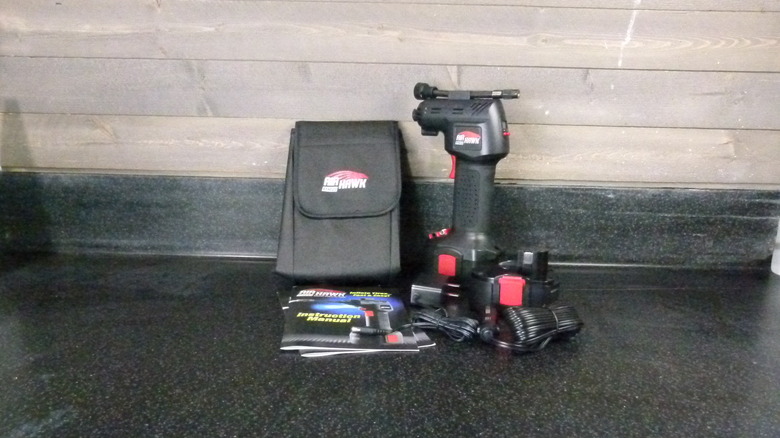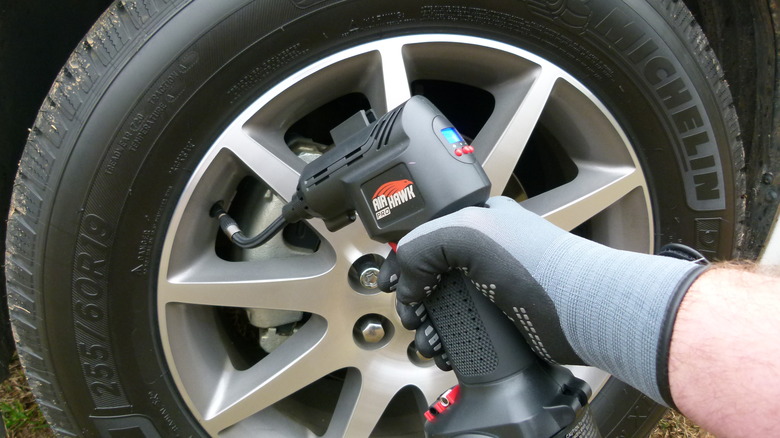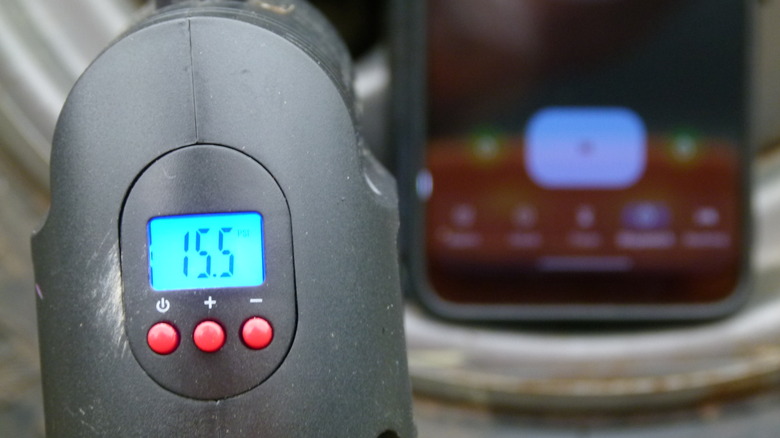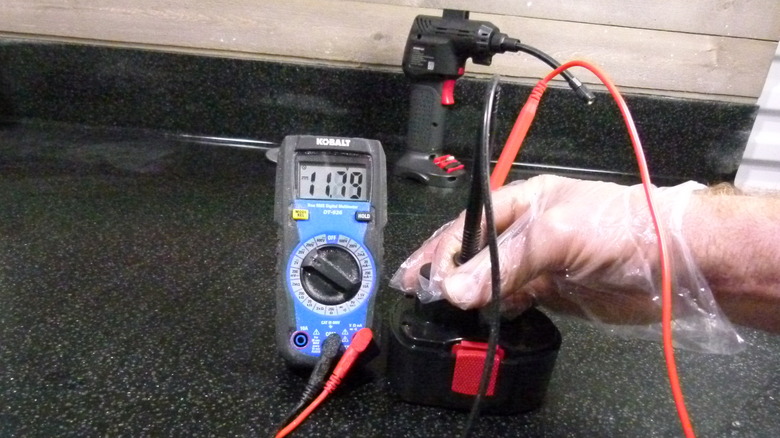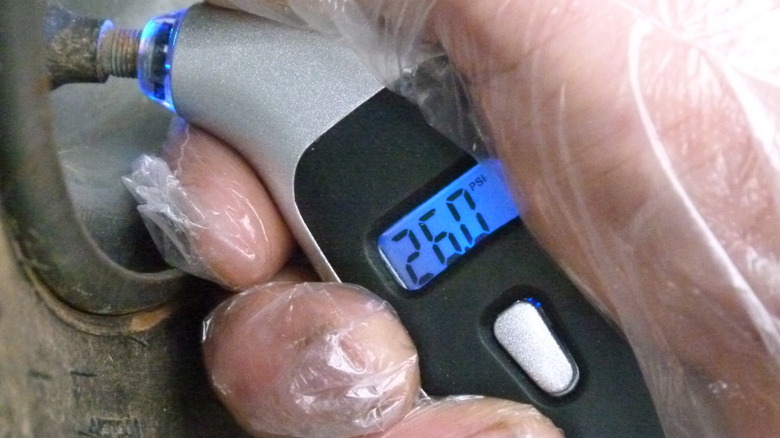We Tried The As-Seen-On-TV Air Hawk Tire Inflator
We may receive a commission on purchases made from links.
"There's a new way to inflate tires," the television commercial exclaims. Meet the $79.87 Air Hawk, a handheld, battery-powered device that "pulls in the outside air and then compresses it into the tire!" What's new about this arrangement is unclear, but it doesn't seem to be the act of compressing air, which was being refined in 13th-century China. And it's not about being cordless, as battery-powered compressors have been around for years. But maybe the novelty is in being battery-powered, small enough to hold, and able to capture the aether and make so much of it fit in your tires.
However groundbreaking it is or isn't, having compressed air on demand is certainly handy. A slow leak can turn into a disaster given enough time, and if you've ever changed a tire on the side of an interstate highway, you know things about fear that most mortals never will. Possibly enough fear to pay $80 to avoid it. (If you followed the link above, you're probably wondering where this $80 figure comes from. At the time of writing, the As Seen On TV website prices the tire inflator at $39.94, but when you click "Add to Cart," you're transported to Amazon, where the things are currently at an all-time high of $79.87.)
As lifelong advocates of not standing on roadsides near trucks in a panicked, just-in-time supply-chain-fueled rush to get to an Amazon distribution center, we gave the Air Hawk Tire Inflator Pro a shot.
The Air Hawk Pro Automatic Cordless Tire Inflator
Amazon features hundreds of battery-powered tire inflators ranging from $7.98 to $557.17. The average price, however, appears to be around $50. There are recognizable brands at predictably higher prices (DeWalt for $127.95, Ryobi for $103.95), and sometimes that doesn't even include a battery. The price of the DeWalt, for example, jumps by at least $60.99 if you buy one that comes with a battery and charger. But, generally speaking, they include batteries and the other goodies that Air Hawk offers.
Those goodies include three valve adapters (auto tire, ball needle, and old-school pool toy inflator nozzles), but unfortunately, no means of inflating items like modern air mattresses, which have much larger ports. But the business of a tire inflator is inflating tires, and on that front, it has several features that should be useful. An LED display and small pushbuttons are used to set a target pressure at which the pump will stop when inflating. In addition to its three adapters, the inflator also comes with a six-inch hose, a carrying case, a battery and charger, and a 12V adapter for running the device from a car's auxiliary power outlet (the cigarette lighter, for those of a certain age). That being said, there is no clear indication of what makes this particular version of the Air Hawk a "Pro" offering.
Some useful comparisons
To check out the Air Hawk, we inflated the tires on three vehicles: a Buick Enclave, a Honda Accord, and an Arctic Cat 400. For testing on the Arctic Cat tire, we used a target pressure of 25 psi for all tests (the tire has a maximum pressure rating of 36 psi, so putting 35 psi into it would be too close for comfort). We removed the valve stem core and emptied the tire between each test. We timed the Air Hawk from 0 to 25 psi using both its battery and the inflator's 12V adapter. It was at this point we learned the Air Hawk does not display tire pressure until it reaches 5 psi.
The Arctic Cat tire reached 25 psi in 8 minutes and 56 seconds with the battery and 7 minutes and 59 seconds using the 12v adapter. While not horrible, it was a far cry from the As Seen On TV boast: "Inflates any tire in just seconds."
For comparison, we also filled the tire to 25 psi in 7 minutes and 38 seconds using an EverStart 750A Jump Starter and Compressor ($37.87 at Walmart). While a lithium-ion battery pack powers the Air Hawk, the EverStart is powered by an internal lead acid battery that can jump-start cars and charge two USB devices. Like the Air Hawk, it has a built-in light, but the EverStart's light is much brighter. The EverStart's air hose is also substantially larger than the Air Hawk's.
Real-world tests of the Air Hawk
On the Buick, we released some air from the tire and checked the Air Hawk's pressure gauge against the car's built-in gauge, as well as a digital pressure gauge known to be reliable. We flattened one of the Honda's tires by pulling the valve stem core, then replacing it and inflating to 35 psi (the inflator's default target pressure).
The Air Hawk's built-in pressure gauge was off by about 1.5 degrees at 25 psi, which is not bad, especially given that the user manual warns that you should "use a separate pressure gauge for a more accurate reading." (Incidentally, the user manual — which is supplied in separate English and French versions, presumably because the Air Hawk is made by a Canadian company — is quite good. It offers 12 detailed pages of instructions and clear illustrations.)
Starting with a freshly charged battery, the device inflated the Accord's 225/50ZR17 tires from 0 to 35 psi in 8 minutes and 44 seconds. A reasonable time for a completely flat tire, perhaps, but certainly not "just seconds." When the inflator automatically shut off, we checked its 35-psi reading against an accurate gauge, which read 36.5 psi, exactly the minor variance we experienced with the Enclave. At this point, the battery measured 11.8 volts. However, when we attempted to resume filling the tire to its normal operating pressure, the Air Hawk would not start, the LED did not light, and nothing was visible on the display.
Give the Air Hawk a pass
After fully charging the battery pack to 12.6 volts, the Air Hawk came back to life, meaning it was only capable of filling a fairly low-profile tire to 35 psi ... too low for safe operation in most circumstances. Even without this failing, the Air Hawk wasn't destined to gain our recommendation. The tool has a decidedly flimsy feel to it. The trigger lock didn't stop the device from being turned on or off. The LED light was so dim as to be useless in most situations.
The battery capacity problem suggests the usefulness of a second battery. The website in the manual for ordering additional batteries does not exist, and while the As Seen On TV site offers replacement batteries for $19.94, it only links to Amazon search results that do not include Air Hawk batteries.
Finally, the manual says that the battery should fully charge in three hours and not longer than five. If this means that the battery pack's lithium-ion cells continue to receive a charging current after being fully charged, that is a dangerous situation that could lead to a fire. If proper overcharge protection is in place, we cannot understand the need for this warning.
As bulky and heavy as it is, the EverStart jump-starter/inflator we timed is a far better option at a better price, and it's possible that many of the cheaper options available on Amazon are superior to the over-priced, under-built Air Hawk.
